Pet-Safe Kitchen Plants That Add Charm to Your Space

Your kitchen should be a sanctuary — for both you and your pets. But finding plants that thrive in kitchen conditions and won’t harm curious cats or sniffing dogs can feel like a narrow path. Fortunately, there’s a collection of beautiful, air-refreshing, and pet-safe houseplants that fit right in with your countertop herbs and cozy décor.
These plants do more than look pretty. They filter the air, bring nature indoors, and won’t put your pets at risk. Whether you grow them for culinary use, humidity control, or a decorative touch, the following pet-safe kitchen plants prove you don’t need to compromise charm for caution.
Table of Contents
Spider Plant (Chlorophytum comosum)
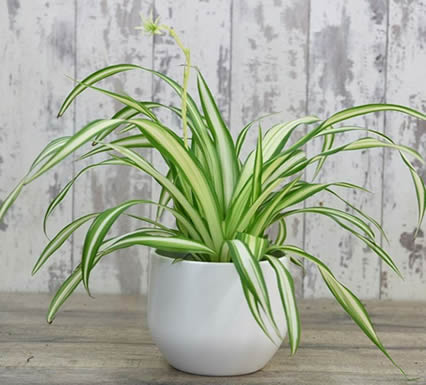
💡 Light: Low to bright, indirect
💧 Water: When the top inch of soil is dry
🌫️ Humidity: Thrives in high humidity
🐾 Pet-Friendly: Yes
Looks: Elegant sprays of green and white variegated leaves arch outward and trail in playful tufts.
Spider plants bring cheerful movement to shelves or hanging pots.
Care: Nearly impossible to kill, spider plants flourish with minimal attention.
Their ability to self-propagate through “spiderettes” makes them ideal for multiplying your pet-safe collection.
Perfect for a kitchen windowsill or shelf near natural light.
For a more detailed care guide see Spider Plant Care: How to Grow a Happy, Trailing Houseplant.
Basil (Ocimum basilicum)
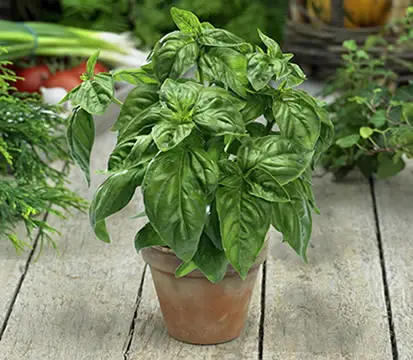
💡 Light: Bright, direct to indirect sunlight
💧 Water: Keep the soil evenly moist
🌫️ Humidity: Moderate
🐾 Pet-Friendly: Yes
Looks: Lush, upright green leaves with a strong, peppery aroma. Brings a rustic Mediterranean feel to your kitchen.
Care: Basil loves warmth and sun.
It thrives in pots placed near sunny kitchen windows and benefits from regular harvesting, which promotes fuller growth.
Bonus: fresh leaves are great for cooking and entirely non-toxic to pets.
For a more detailed care guide see Basil Plant Care: How to Grow This Fragrant Culinary Herb Indoors and Out.
Calathea (Calathea spp.)

💡 Light: Medium, indirect
💧 Water: Keep soil consistently moist
🌫️ Humidity: High
🐾 Pet-Friendly: Yes
Looks: Intricately patterned leaves with bold striping, rich purples, and velvety textures. A statement plant that doubles as living art.
Care: Prefers filtered light and higher humidity, making the kitchen a great location — especially if you cook often.
Mist regularly or keep near a sink or kettle station for moisture.
For a more detailed care guide see Calathea Care: How To Keep Your Prayer Plant Thriving Indoors.
Peperomia (Peperomia spp.)

💡 Light: Bright, indirect
💧 Water: Let soil dry slightly between waterings
🌫️ Humidity: Moderate
🐾 Pet-Friendly: Yes
Looks: Thick, waxy leaves in an array of patterns and colors — from emerald ripples to variegated stripes.
Care: Peperomia is compact, stylish, and perfect for countertops or window ledges.
It doesn’t need much space, making it ideal for smaller kitchens.
It’s also highly adaptable to lower light conditions.
For a more detailed care guide see Peperomia Plant Care. Beginner Guide & Expert Tips.
Lemon Balm (Melissa officinalis)

💡 Light: Full sun to part shade
💧 Water: Keep the soil moist but not soggy
🌫️ Humidity: Moderate
🐾 Pet-Friendly: Yes
Looks: Soft, bright green leaves with a refreshing citrus scent.
Grows in a bushy, upright form that’s easy to pinch and maintain.
Care: Lemon balm is a calming herb — both visually and aromatically.
Great in teas or added fresh to dishes, it’s a soothing plant that your pets can safely sniff.
For a more detailed care guide see Lemon Balm Care: How To Grow This Calming Herb Indoors or Out.
Thyme (Thymus vulgaris)

💡 Light: Full sun
💧 Water: Allow top inch of soil to dry between waterings
🌫️ Humidity: Tolerates dry air
🐾 Pet-Friendly: Yes
Looks: Dainty, silver-green leaves on woody stems.
Low-growing with a sprawling habit that’s both charming and practical.
Care: Place near a south-facing kitchen window for best results.
Thyme is drought-tolerant, pest-resistant, and wonderfully fragrant when brushed.
For a more detailed care guide see Thyme Plant Care: Grow This Hardy Herb for Culinary and Ornamental Use.
Baby’s Tears (Soleirolia soleirolii)

💡 Light: Bright, indirect
💧 Water: Keep consistently moist
🌫️ Humidity: Loves high humidity
🐾 Pet-Friendly: Yes
Looks: A carpet of tiny, coin-shaped leaves that spill over pots or creep across soil like green lace. Soft and whimsical.
Care: Baby’s Tears love humid environments and do well near sinks or stovetops.
They’re delicate but fast-growing — just be careful not to let them dry out.
For a more detailed care guide see Baby’s Tears Care: How To Grow This Soft Groundcover Indoors or Out.
Areca Palm (Dypsis lutescens)
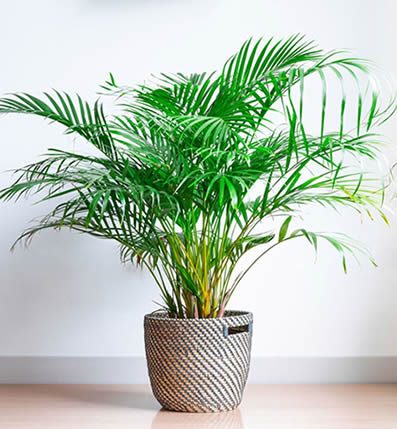
💡 Light: Bright, indirect
💧 Water: When top inch of soil is dry
🌫️ Humidity: High
🐾 Pet-Friendly: Yes
Looks: Feathery fronds with a light, tropical presence.
Adds height and movement to corners or floor pots in the kitchen.
Care: Mist regularly and avoid cold drafts.
It’s one of the few large indoor palms that are completely safe for pets, making it a striking and stress-free option.
For a more detailed care guide see Areca Palm Care: Growing a Lush, Tropical Statement Plant.
Mint (Mentha spp.)
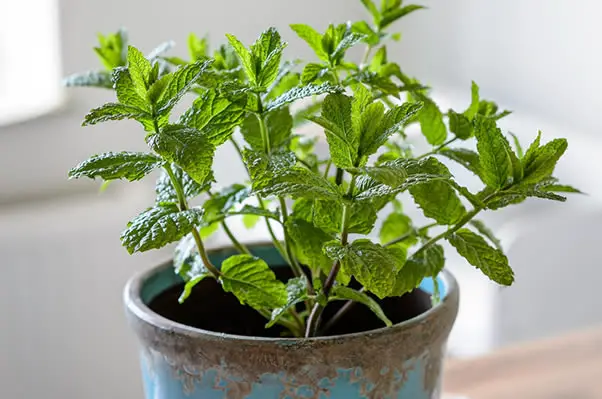
💡 Light: Bright, indirect to partial sun
💧 Water: Keep soil consistently moist
🌫️ Humidity: Moderate
🐾 Pet-Friendly: Yes
Looks: Vibrant green leaves with a crisp scent. Upright and bushy with fast growth when happy.
Care: Mint grows aggressively, so give it its own pot or container.
Great for freshening up drinks and recipes — and entirely safe for pets to sniff or chew (in moderation).
For a more detailed care guide see Mint Plant Care: How to Grow This Refreshing Herb Indoors and Out.
Parlor Palm (Chamaedorea elegans)
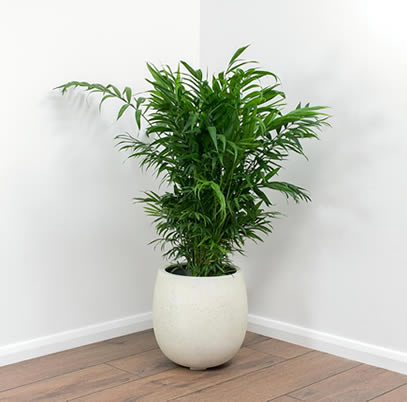
💡 Light: Low to medium, indirect
💧 Water: Water when soil is dry halfway down
🌫️ Humidity: Prefers higher humidity
🐾 Pet-Friendly: Yes
Looks: Graceful green fronds arching from slender stems. Soft, flowing, and distinctly elegant.
Care: One of the easiest indoor palms to grow, and ideal for kitchens with moderate light.
Works well on the floor or in a raised pot beside a sunny breakfast nook.
For a more detailed care guide see Parlour Palm Care: How to Grow the Elegant, Low-Light Chamaedorea Elegans.
Final Word
You shouldn’t have to sacrifice style — or the safety of your furry companions — to enjoy a kitchen full of greenery.
With the right selection, you can create a fresh, vibrant, and pet-safe space that’s just as inviting for your pets as it is for your cooking.
These plants offer fragrance, form, and function, all while posing no risk to curious noses or playful paws.
Place them on your windowsills, countertops, or hanging baskets and enjoy the peace of mind that comes with beauty and safety in one pot.
Thanks for reading! I'm Michael — houseplant fanatic and your Pinterest plant guide.
Follow me on Pinterest for fresh updates 🌿



